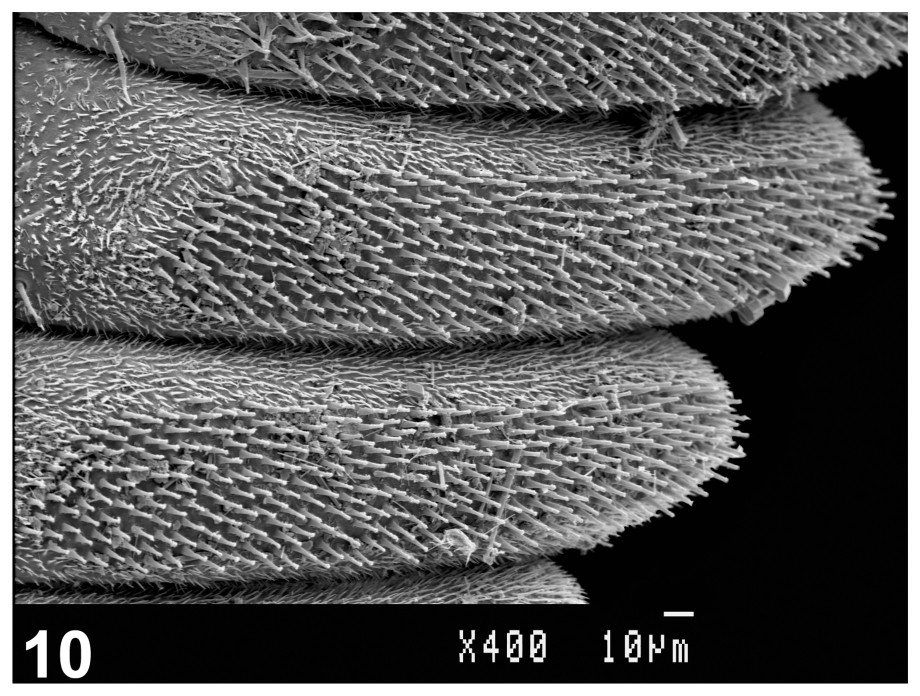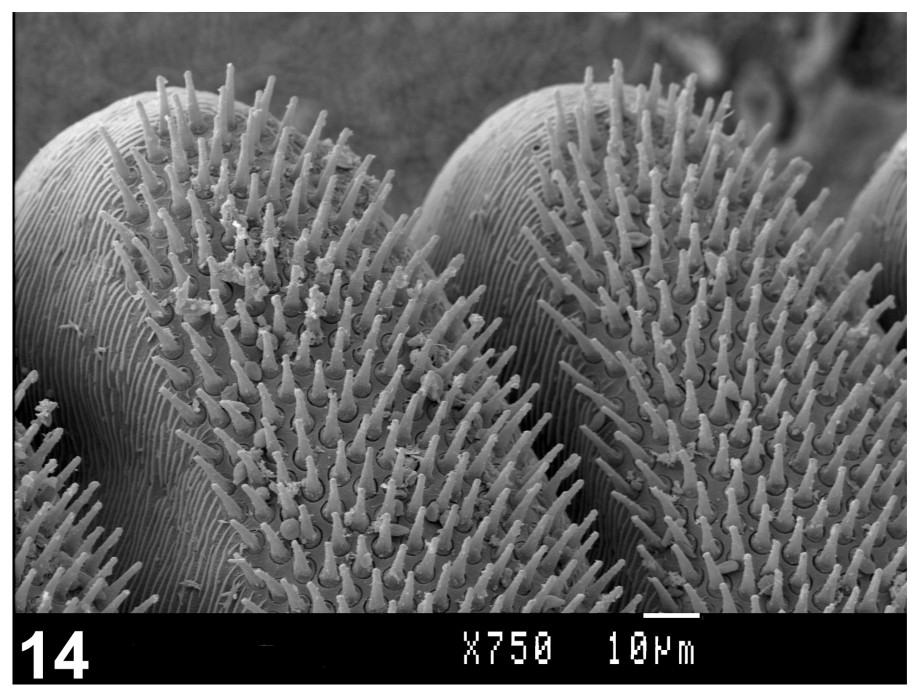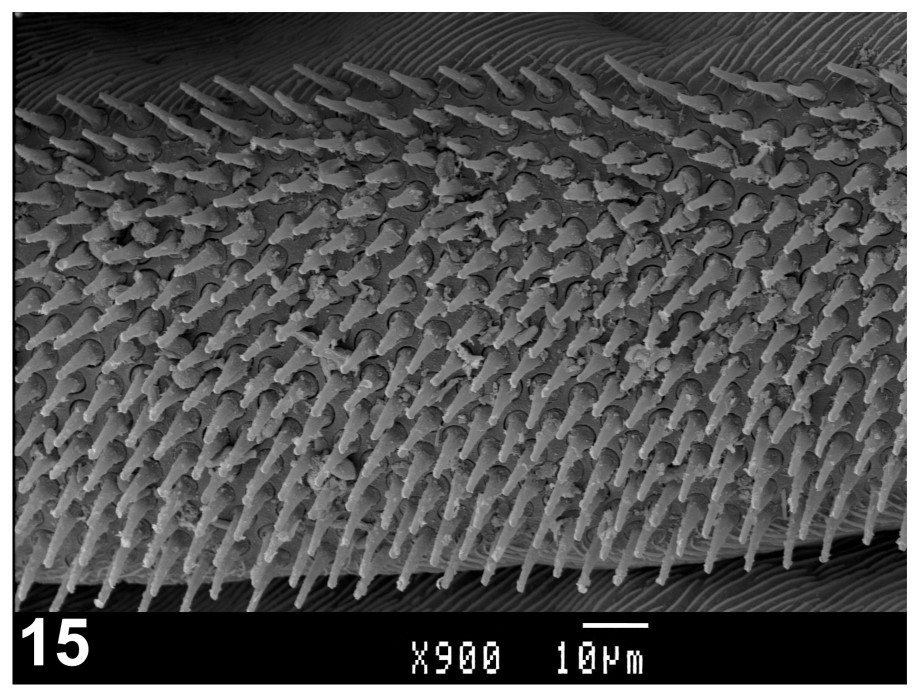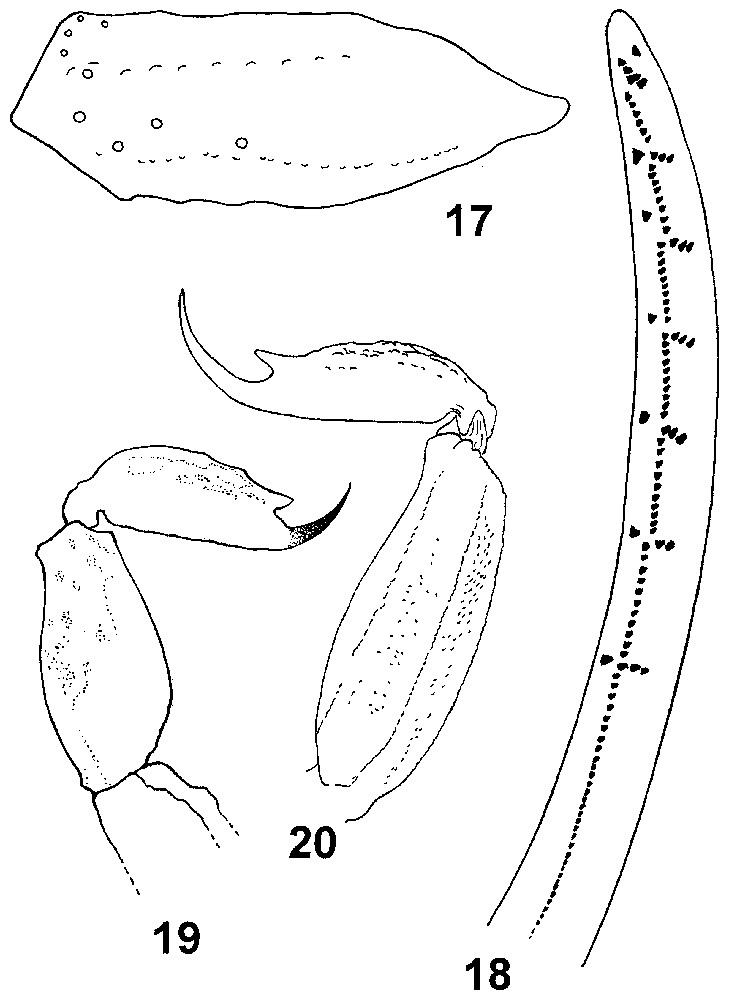Version française abrégée
1 Introduction
Les scorpions humicoles sont globalement rares. Le premier cas décrit avec précision a été Akentrobuthus leleupi Lamoral, un micro Buthidae découvert dans les forêts de la province du Kivu au Congo. Avant cette découverte, le seul scorpion considéré comme humicole était Belisarius xambeui, élément endémique des Pyrénées orientales de France et d'Espagne. Peu de temps avant la description d'A. leleupi, un autre genre et espèce nouveaux, Lychasioides amieti Vachon, avaient été décrits de la forêt d'Otomoto au Cameroun. Selon le collecteur de cette espèce, le professeur J.-L. Amiet, elle a été trouvée également dans des sols organiques, ce qui lui permet d'être considérée comme un élément humicole. Plus récemment, un nouveau genre, Microcharmus Lourenço, composé uniquement de vraies espèces humicoles, a été décrit de Madagascar. La découverte de plusieurs espèces nouvelles et même d'un deuxième nouveau genre a permis d'isoler ce groupe de micro-scorpions dans une famille à part, celle des Microcharmidae Lourenço. À présent, un nouveau genre et une nouvelle espèce de micro-scorpion Buthidae humicole, Microananteris minor sp. n., sont décrits de la Guyane française.
2 Analyse comparative des papilles sensorielles des peignes
La majorité des études existantes sur les papilles sensorielles des peignes de scorpions font référence à leur rôle de chémorécepteur, voire à quelques aspects de leur physiologie. Néanmoins, les particularités morphologiques des papilles sensorielles sont également à considérer dans les études de phylogénie ou d'adaptation écologique. Jusqu'à présent, un bon nombre d'espèces appartenant à différents genres et familles ont été étudiées au microscope électronique à balayage. Des résultats préliminaires mènent à deux types de conclusions : (i) dans les groupes familiaux ou génériques, les structures des papilles trouvées pour la majorité des espèces sont très similaires ; (ii) les espèces appartenant à des groupes distincts, mais adaptées à des milieux écologiques semblables, peuvent présenter des structures de papilles similaires.
Les observations faites pour les espèces du genre Ananteris (Figs. 1–4) montrent des papilles en forme de spatule, revêtue d'un tégument avec des structures spinoı̈des. Chez le nouveau genre et espèce à présent décrits, les papilles ont une forme très différente, plutôt arrondie, comme des petites bouteilles (Figs. 5–8). On retrouve néanmoins un tégument avec également des structures spinoı̈des, ce qui suggère une possible association phylogénétique avec le genre Ananteris. L'observation des papilles sensorielles de deux autres espèces humicoles, Lychasioides amieti (Figs. 9–12) et Microcharmus fisheri (Figs. 13–16), montrent une structure arrondie, en forme de bouteille, similaire à celle observée chez M. minor sp. n. D'autres espèces humicoles devront être étudiées au MEB, pour confirmer le modèle observé.




Ananteris balzanii (female). 1. Pecten. 2–4. Microstructure of peg-shaped sensilla on teeth. Notice the characteristic seta-like structure of the tegument in the zones around the region of the peg sensillae (2–3) and between the peg sensillae (4).




Microananteris minor gen. n. sp. n. (female holotype). Idem Figs. 1–4.




Lychasioides amieti (female paratype). Idem Figs. 1–4.




Microcharmus fisheri (male paratype). Idem Figs. 1–4.
1 Introduction
Humicolous scorpions are globally rare. The first instance to be precisely reported was that of Akentrobuthus leleupi, a buthid found in forests of the Kivu Province in Congo and described by Lamoral [1]. According to Lamoral [1], the only humicolous species previously described had been Belisarius xambeui. Belisarius is a monotypic genus endemic to forests and caves of eastern Pyrenees in France and Spain. It is now accommodated in the family Troglotayosicidae. Just before the publication of Lamoral [1], Vachon [2] described a new genus and species, Lychasioides amieti from the forest of Otomoto in Cameroon. According to the collector of this species, Prof. J.-L. Amiet, it was also to be found in organic soil. It was therefore considered as humicolous (Vachon, in litt.). More recently, a new genus of true humicolous buthid scorpions, Microcharmus, was described from Madagascar [3]. With the discovery of several new species and a second new genus, this group of micro-scorpions has been accommodated in its own family Microcharmidae [3–7].
In this paper, a new genus and species of humicolous buthid scorpion is described from French Guyana. It is to some extent associated with the genus Ananteris, but important differences in the structure of the peg-shaped sensillae of the pectines are revealed by scanning electron microscopy. It is suggested that these differences may be an adaptation to the soil dwelling life of these humicolous scorpions. The new genus and species described here represent the first humicolous scorpion to be reported in the Neotropical region.
2 Comparative analysis of microstructure of pectine peg-shaped sensilla in some groups of micro-buthid scorpions
Although almost all existing studies of the peg-shaped sensillae of scorpion pectines refer to their chemosensory role and aspects of physiology [8], their structure can also be useful in studies of phylogeny and adaptation. Until now, quite a number of species in several genera and families have been investigated by scanning electron microscopy. Preliminary results lead to two conclusions: (i) in a given familial or generic group, the structures of the sensillae are very similar in most species of the group [9], (ii) species belonging to different groups but living in similar environments may present similar types of peg-shaped sensillae (this study).
The observations carried out on species of the genus Ananteris (Figs. 1–4; Lourenço unpublished) reveal similar spatula-like peg-shaped sensillae in all the species, with a characteristic seta-like structure of the tegument in the zones around and between the peg-shaped sensillae. In the new genus and species, Microananteris minor sp. n., the peg-shaped sensillae are marked different, with a round structure more like a bottle (Figs. 5–8). Curiously, the seta-like structure of the tegument in the zones around and between the peg-shaped sensilla is also present, attesting to a possible phylogenetic association with the genus Ananteris. The study peg-shaped sensillae of two other humicolous species, Lychasioides amieti (Figs. 9–12) and Microcharmus fisheri (Figs. 13–16) show peg-shaped sensillae with a rounded structure similar to those of M. minor sp. n. Further studies on other humicolous species will be necessary to confirm this pattern.
3 Taxonomic treatment
3.1 Microananteris gen. n.
Diagnose. Very small scorpions, when compared with the average size of most species of micro-buthid genera, and measuring 11.7 mm in total length (see morphometric values). It can be readily distinguished from all the other known genera of micro-buthoids and in particular of the genus Ananteris Thorell by (i) the very small pectines, with the distal teeth rounded and only 10 teeth, the proximal ones absent; (ii) sternum subpentagonal; (iii) the characteristic structure of the peg sensillae of the pectines, which are quite different from those found in Ananteris species; (iv) the spiracles having a semi-oval shape; (v) the ‘pear-like’ shape of the telson and a very short aculeus. This new humicolous genus is possibly an endemic element to the soils of the humid forests of Central French Guyana.
Type species of the genus.Microananteris minor sp. n. (Figs. 5–8, 17–20).

Microananteris minor gen. n. sp. n. (female holotype). 17. Femur, dorsal aspect, showing beta configuration for trichobothria. 18. Cutting edge of movable finger with rows of granules. 19. Metasomal segment V and telson, lateral aspect. 20. Idem, for Ananteris balzanii (female).
Type-material female holotype. French Guyana, Central region, near to the village of Saül, 2 km SW of the air field; dense humid forest at low altitude; in organic soil (extracted by the Berlese method), 19/III/1999 (J.-M. Betsch leg). No paratypes. Deposited in the ‘Muséum national d'histoire naturelle’, Paris, RS-8602. Etymology: the specific name makes reference to the small size of the new species.
Description. Coloration. Basically brownish-yellow, symmetrically marbled with darker brown, producing an overall spotted appearance. Prosoma: carapace yellowish, almost totally covered with brown spots; eyes surrounded by black pigment. Mesosoma: yellowish-brown with confluent brown stripes. Metasoma: segments I to V yellowish, with several pale brown spots; segment V with more marked spots. Telson: vesicle yellowish with pale brownish spots laterally and ventrally; aculeus reddish. Venter pale yellow. Chelicerae yellowish with variegated spots over their entire surface; more marked anteriorly; fingers yellowish with reddish teeth. Pedipalps: yellowish densely marked with brownish spots better marked on the femur and patella; chela paler than patella; fingers brownish with the rows of granules slightly reddish. Legs yellowish, densely marked with brownish spots.
Morphology. Carapace moderately granular; anterior margin with a very slight median concavity, almost straight. Anterior median superciliary and posterior median carinae weak. All furrows moderate to weak. Median ocular tubercle distinctly anterior to the centre of carapace; median eyes separated by approximately 0.70 of ocular diameter. Three pairs of lateral eyes. Sternum subpentagonal. Mesosoma: tergites moderately to weakly granular. Median carina moderate to weak in all tergites. Tergite VII pentacarinate. Venter: genital operculum divided longitudinally, each plate having a more or less triangular shape. Pectines very small: pectinal tooth count 10–10; basal middle lamellae of the pectines not dilated; fulcra absent. Sternites smooth with short semi-oval spiracles; VII with a few granulations and vestigial carinae. Metasoma: segment I to III with 10 carinae, crenulate. Segment IV with 8 carinae, crenulate. Intercarinal spaces moderately to weakly granular. Segment V with 5 carinae. Telson with a ‘pear-like’ shape, almost smooth with three ventral carinae; aculeus very short and moderately curved; subaculear tooth strong and almost rhomboid. Cheliceral dentition characteristic of the family Buthidae [10]; fixed finger with two moderate basal teeth; movable finger with two very weak basal teeth; ventral aspect of both finger and manus with dense, long setae. Pedipalps: femur pentacarinate; patella and chela with a few vestigial carinae; internal face of patella with some vestigial granules; all faces feebly granular, almost smooth. Movable fingers with 6/7 almost linear rows of granules; two accessory granules present at the base of each row; extremity of movable fingers with three accessory granules. Trichobothriotaxy; orthobothriotaxy A-β [2,11]. Legs: tarsus with very numerous fine median setae ventrally. Tibial spurs developed on leg. IV but reduced on leg. III.
Morphometric values (in mm) of the new species described. Total length, 11.7. Carapace: length, 1.7; anterior width, 1.2; posterior width, 1.8. Metasomal segment I: length, 0.9; width, 1.1. Metasomal segment V: length, 2.1; width, 1.1; depth, 0.9. Vesicle: width, 0.9; depth, 0.8. Pedipalp: femur length, 1.4, width, 0.4; patella length, 1.8, width, 0.6; chela length, 2.2, width, 0.4, depth, 0.4; movable finger length, 1.6.
Acknowledgements
I am very grateful to Laurent Albenga and Didier Geffard, ‘Département de systématique et d’évolution, Muséum national d'histoire naturelle', Paris, for their help in the preparation of the illustrations, and to Profs. John L. Cloudsley-Thompson, London, and J.-M. Betsch, ‘Muséum’, Paris, for reviewing the manuscript.


